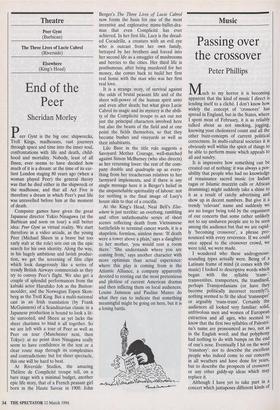Theatre
Peer Gynt (Barbican) The Three Lives of Lucie Cabrol (Riverside)
Elsewhere (King's Head)
End of the Peer
Sheridan Morley
Peer Gynt is the big one: shipwrecks, Troll Kings, madhouses, vast journeys through space and time into the inner soul, confrontations with life and death, child- hood and mortality. Nobody, least of all Ibsen, ever seems to have decided how much of it is a dream: at the time of its ear- liest London staging 80 years ago (when a woman played Peer) the general theory was that he died either in the shipwreck or the madhouse, and that all Act Five is therefore a dream in which Peer's past life was unravelled before him at the moment of death.
Computer games have given the great Japanese director Yukio Ninagawa (at the Barbican and soon on tour) a still better idea: Peer Gynt as virtual reality. We start therefore in a video arcade, as the young Peer (Michael Sheen in a brave but too early stab at the role) sets out on the epic search for his own identity. Along the way, in his hugely ambitious and lavish produc- tion, we get the screening of film clips which look dangerously like a series of trendy British Airways commercials as they try to convey Peer's flight. We also get a couple of splendid performances from the kabuki actor Haruhiko Joh as the Button- moulder, and the Norwegian Espen Skon- berg as the Troll King. But a multi-national cast in an Irish translation (by Frank McGuinness) of a Scandinavian classic in a Japanese production is bound to look a lit- tle unrooted, and Sheen as yet lacks the sheer charisma to bind it all together. So we are left with a tour of Peer as well as Peer on tour (Manchester next, then Tokyo): at no point does Ninagawa really seem to have confidence in the text or a clear route map through its complexities and contradictions: but for sheer spectacle, this one will be hard to beat.
At Riverside Studios, the amazing Theatre de Complicite troupe tell, on a bare stage with a minimal budget, another epic life story, that of a French peasant girl born in the Haute Savoie in 1900. John Berger's The Three Lives of Lucie Cabrol now forms the basis for one of the most inventive and explorative mime-ballet-dra mas that even Complicite has ever achieved. In her first life, Lucy is the dread- ed Cocadrille, a creature with an evil eye who is outcast from her own family, betrayed by her brothers and forced into her second life as a smuggler of mushrooms and berries to the cities. Her third life is posthumous; after being murdered for her money, she comes back to build her first real home with the man who was her first real love.
It is a strange story, of survival against the odds of brutal peasant life and of the sheer will-power of the human spirit unto and even after death; but what gives Lucie Cabrol its magic and its mystery is the abili- ty of the Complicite troupe to act out not just the principal characters involved here but also the beasts of the field and at one point the fields themselves, so that they become bushes and vineyards as well as their inhabitants.
Lilo Baur in the title role suggests a Savoyard Mother Courage, well-matched against Simon McBurney (who also directs) as her returning lover: the rest of the com- pany double and quadruple up as every- thing from her treacherous relatives to her farmyard implements, and if there is any single message here it is Berger's helief in the unquenchable spirituality of labour: not for nothing is the final image of Lucy's house akin to that of a crucifix.
At the King's Head, Neal Bell's Else- where is just terrible: an overlong, rambling and often unfathomable series of short scenes reflecting death from Vietnamese battlefields to terminal cancer wards, it is a shapeless, formless, aimless mess: 'If death were a tower above a plain,' says a daughter to her mother, 'you would rent a room there.' She understands where you are coming from,' says another character with more optimism than actual experience: where this play is coming from is the Atlantic Alliance, a company apparently devoted to rooting out the most pretentious and plotless of current American dramas and then inflictng them on local audiences. Louise Jameson and Pauline Munro do what they can to indicate that something meaningful might be going on here, but it is a losing battle.


















































 Previous page
Previous page